the NachtKabarett
 |
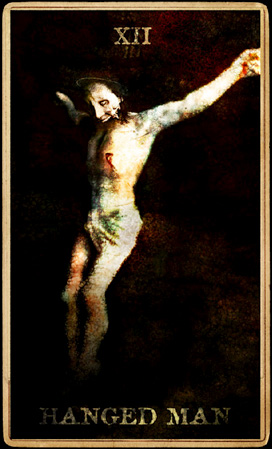 |
 |
She tells me I'm a pretty bullet, an imitation ChristMarilyn Manson, The Love Song
I've got love songs in my head, killing us away
The above are lyrics to 'The Love Song', one of the most signature tracks on 'Holy Wood' which illustrated the ethos of what the album represents; an indictment of growing up in America's violently predisposed, death obsessed culture. Just as illustrated throughout The NACHTKABARETT, 'Holy Wood' by far is Manson's most multifaceted and multi-allusioned work to date. As Manson mentioned throughout recording 'Holy Wood', the album was intended to be a reinterpretation of Christianity and its original esoteric traditions, rather than the attempt to destroy the religion altogether as was set forth in Antichrist Svperstar. This specific verse, although dually illustrates the persona of Christ which Manson portrayed on the album's cover along with the themes within, also makes reference to a 15th Century book on Christian Mysticism known as 'The Imitation of Christ' by Thomas à Kempis.
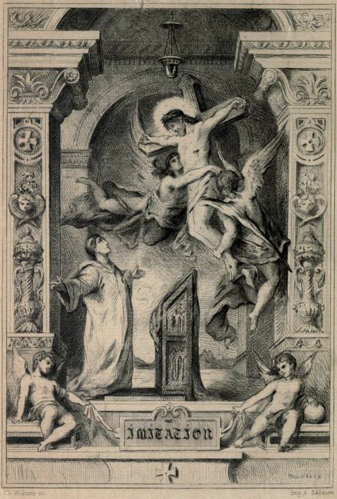 |
 |
| Left; illustration from a French 1878 edition of 'The Imitation of Christ'. Right; Rubens's Crucifixion, 1620, possibly the Renaissance painting Manson wished to imitate. Note the composition and colors, and how Christ's shadow virtually obscures the cross, which tends to disappear (see The Tarot & Holy Wood). | |
The book is related to another 15th Century text on esoteric Christian Mysticism, 'The Cloud of Unknowing', which is one of the books that proved to be very inspirational to Aleister Crowley's pursuit of the hidden and occult after reading at a young age. 'The Imitation of Christ' however is a spiritual guidebook which directs the adept in the purification of the soul by using the life of Christ as the highest divine example, literally 'imitating' Christ. On a foundational level this is also a tenet aim of true spiritual alchemical philosophy.
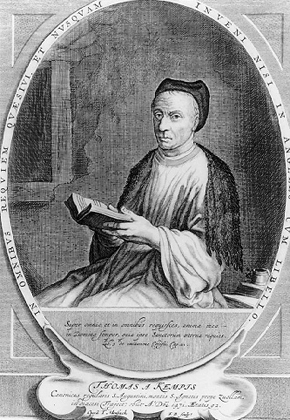 |
 |
In relation to the themes outlined within Holy Wood, the evocation of the title acts as double entendre of Christ being appropriated as a figurehead of Celebritarianism (or public martyrdom which acts as a 'suffering unto death' life path observed by those whom Manson indicts as finding death to be the ultimate determinant of celebrity status to be posthumously, and metaphorically, consumed) and the personification Manson, as the album's protagonist, assumes in likening his mission of socio-religious revolution to that which Christ set forth in his own time. Both cases 'imitating Christ', with the former case being a perversion of his original teachings by the subjugated masses and the latter being a metaphorical comparison of taking Christ's example to enact a campaign of influence upon the world while purifying one's own soul to ultimately become an ascended master, as did Christ himself.
 |  |
| Manson as a jawless Christ rotting on his cross on Holy Wood's cover, which also echoes the earlier gruesome, dislocated Christ similarly deteriorated by plague stigmata and intense suffering which was depicted on the central panel of Matthias Grünewald's Isenheim Altarpiece, from 1516 (right). | |
Another reference of interest is Alejandro Jodorowsky's 1973 film 'The Holy Mountain', in which the main character, a transposed Christ, wanders in a warehouse amongst heaped plaster replicas made of himself into a crucified posture. This sequence, which also inspired a passage of 'The Dope Show' video in which Manson destroys dozens of replicas of himself (or "samples of a soul"), perfectly illustrates the expression "imitation christ", though it's more connected to religious mercantilism and artificiality.
"you're just a copy of an imitation"Marilyn Manson, Target Audience
 Still frame from Jodorowsky's Holy Mountain, showing a factory of identical heaped life-size plaster Christs. The idea
Still frame from Jodorowsky's Holy Mountain, showing a factory of identical heaped life-size plaster Christs. The ideais also echoed in the Hanged Man card above in terms of shape, as Manson is crucified on nothing/in space.
Now, with Holy Wood, Manson takes everything America holds as righteous and places himself within it. "For example, I've decided that, rather than not believing the story of Christ, I'm gonna believe it on my own terms; I'm gonna turn it around and make it work for me. Instead of saying I'm the opposite of Christ, now I can say I'm the same thing as Christ. Because in the end, the characters of Marilyn Manson or Christ - or Lucifer, for that matter - all end up being the same. We each represent something that America wants, and maybe needs, in order to keep itself going."Marilyn Manson, Interview for Revolver, Winter 2000
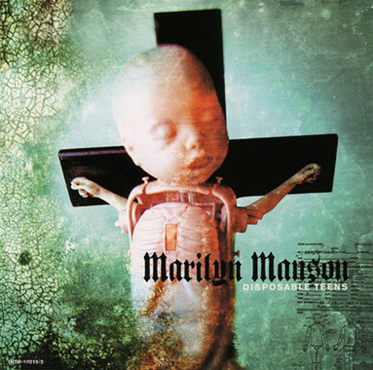 |
 |
| Left; cover for the single "Disposable Teens", the visual from which was also used as a background projection during the God, Guns and Government tour; an illustration of the "media exploitation and grotesque coverage of events like Columbine" (also note the inclusion of JFK's autopsy sheet at bottom-right). The plastic features are not the only elements following the 'imitation' theme, as the whole composition itself actually evokes/imitates a long-time Christian tradition of representing the infant/baby Jesus sleeping on his cross (right: "Gesù Bambino dormiente sulla croce", private collection, Milan). |
|
"I'm tired to die for your fucking sins"Marilyn Manson, live performances of The Reflecting God
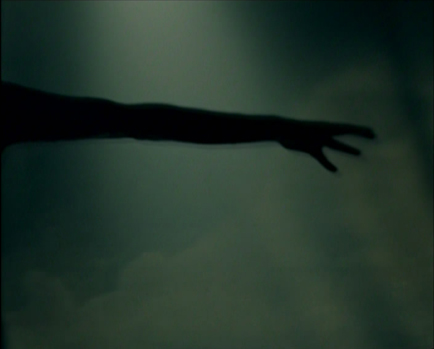 |
 |
| Left; silhouette of a Christic arm appearing subliminally at the beginning of the "Diposable Teens" video. Right; Manson as the Pope in front of the Holy Cross. Both depictions seem to attenuate through subtle evocations, the actual violence of the crucifixion Manson mentionned in numerous interviews. |
|
The media, even the meddling government, were quick to vilify art, post-Columbine, rechons Manson, art's most devoted defender. "But there isn't any image around that's more grotesque or violent than this," he snaps, pointing to a crucifix dangling directly overhead. "And I don't think you're gonna find any writing that's more offensive than stuff in the Bible."Marilyn Manson, Interview for Alternative Press, November 2000
 |
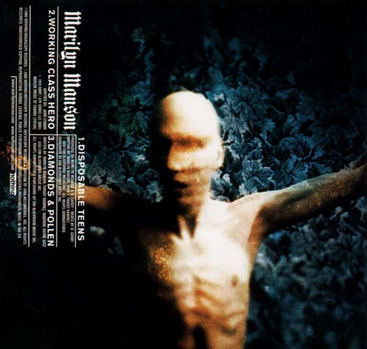 |
| Left; Manson as the sacrificial body of Christ, devoured by his disciples in a Celebritarian display, from the 'Disposable Teens' video. The concept of the Eucharist, echoes Manson's evocations of The Lamb Of God during the era, will later be an inspiration for the title of 'Eat Me, Drink Me'. Right; the 'Disposable Teens' single's back cover, Manson/Adam as a faceless Christ-like figure in an artificial Garden of Eden / Holy Wood. |
|
Though not specifically related to the matter at hand, the title was also somewhat popularized in 1980 when The Psychedelic Furs released a song named 'Imitation of Christ' on their self-title debut album.
As shown in the three examples below, and the non-exhaustive chronologic list of Manson's various Christ-like incarnations and crucifixions which directly follows, the references to Christ have always occupied a central place in Marilyn Manson, and seem to create a narration on their own, even beyond the Triptych :
 |
 |
 |
| Earlier imitations/alterations of Christ on a Spooky Kids 1991 newsletter, an Antichrist Superstar 1996 promo shoot by Joseph Cultice, and another Grunewald-esque vision, in 'The Long Hard Road Out Of Hell' video from 1997, which was also used for a submenu of the 'Lest We Forget' DVD. | ||

S e e a l s o o n T h e N A C H T K A B A R E T T :
 THE THIRD & FINAL BEAST - THE ANTICHRIST | "Only by taking on the persona of Christ can the magus (or magician) use the [power of Christ] with maximum effect in commanding [the elements].This is a poorly understood secret of magic, but absolutely vital: the magician in him or herself is a fallible human being, and can perform no more than the works of a human, but when he or she takes on the identity of a god, the magician is rendered to perform the works of a god." The Tetragrammaton, by Donald Tyson.
THE THIRD & FINAL BEAST - THE ANTICHRIST | "Only by taking on the persona of Christ can the magus (or magician) use the [power of Christ] with maximum effect in commanding [the elements].This is a poorly understood secret of magic, but absolutely vital: the magician in him or herself is a fallible human being, and can perform no more than the works of a human, but when he or she takes on the identity of a god, the magician is rendered to perform the works of a god." The Tetragrammaton, by Donald Tyson.

 THE MECHANICAL CHRIST | "And in the midst of the seven candlesticks
one like unto the Son of man, clothed with a garment down to the foot,
and a girt about the paps with a golden girdle. His head and hairs were
white like wool, as white as snow; and his eyes were as a flame of fire..."
Revelation 1:13-14
THE MECHANICAL CHRIST | "And in the midst of the seven candlesticks
one like unto the Son of man, clothed with a garment down to the foot,
and a girt about the paps with a golden girdle. His head and hairs were
white like wool, as white as snow; and his eyes were as a flame of fire..."
Revelation 1:13-14
Manson during the Mechanical Animals era. The opening song of each performance of the subsequent tour being named 'Inauguration of the Mechanical Christ'.

 THE LAST TOUR ON EARTH | "O most sorrowful Mother Mary, meditating on the Mystery of the Crucifixion, when, having been stripped of His garments, thy Divine Son was nailed to the Cross, upon which He died after three hours of indescribable agony, during which time He negged from His Father forgiveness for His enemies, I humbly pray : (...) ." The Fifth Sorrowful Mystery from The Rosary Novena to Our Lady.
THE LAST TOUR ON EARTH | "O most sorrowful Mother Mary, meditating on the Mystery of the Crucifixion, when, having been stripped of His garments, thy Divine Son was nailed to the Cross, upon which He died after three hours of indescribable agony, during which time He negged from His Father forgiveness for His enemies, I humbly pray : (...) ." The Fifth Sorrowful Mystery from The Rosary Novena to Our Lady.
Inauguration, Crucifixion, and Resurrection through fire of the Mechanical Christ as illustrated in the artwork for The Last Tour on Earth live album.

 KENNEDY & KING KILL 33° | "There are a lot of references to the way that I see John F. Kennedy as a modern day Christ and how religion kind of sprouts from that. It's really a strange story, but in the end it's a parable about fame and love and what matters to you the most, but I can't say it's got a happy ending. The video for 'Coma White' is adapted from my script, so it will be a bit of a teaser, a hint at what people can expect... Though I'm sure they won't understand it or make it any clearer. " Marilyn Manson, 1999 interview for Metal Edge.
KENNEDY & KING KILL 33° | "There are a lot of references to the way that I see John F. Kennedy as a modern day Christ and how religion kind of sprouts from that. It's really a strange story, but in the end it's a parable about fame and love and what matters to you the most, but I can't say it's got a happy ending. The video for 'Coma White' is adapted from my script, so it will be a bit of a teaser, a hint at what people can expect... Though I'm sure they won't understand it or make it any clearer. " Marilyn Manson, 1999 interview for Metal Edge.

 HOLY WOOD & THE HANGED MAN | "The ironic part about the cover is that my point has been to say that entertainment is blamed so much for violence, and the image of the crucifix is a very violent image. The actual way that was created my album cover was a combination of a photograph of Christ from a Church (it's not my body), and I incorporated my face into it and turned it into sort of a Renaissance painting, and the fact that they found it to be offensive proves my point. The symbolism of the jaw being removed says a lot about how people with opinions including Christ himself have always been destroyed for what they have to say." Marilyn Manson, 2000.
HOLY WOOD & THE HANGED MAN | "The ironic part about the cover is that my point has been to say that entertainment is blamed so much for violence, and the image of the crucifix is a very violent image. The actual way that was created my album cover was a combination of a photograph of Christ from a Church (it's not my body), and I incorporated my face into it and turned it into sort of a Renaissance painting, and the fact that they found it to be offensive proves my point. The symbolism of the jaw being removed says a lot about how people with opinions including Christ himself have always been destroyed for what they have to say." Marilyn Manson, 2000.

 CRUCI-FICTION IN SPACE | One of the most signature tracks on Holy Wood whose origins are inspired from various aged esoteric texts and which was enacted onstage during the 'Guns, God & Goverment Tour' in support of the album bearing the song. The song's title comes from the name J. P. Lundy gave to a mysterious pre-Christian depiction of an Indian god crucified in the clouds, which was also reproduced in the artwork for Holy Wood.
CRUCI-FICTION IN SPACE | One of the most signature tracks on Holy Wood whose origins are inspired from various aged esoteric texts and which was enacted onstage during the 'Guns, God & Goverment Tour' in support of the album bearing the song. The song's title comes from the name J. P. Lundy gave to a mysterious pre-Christian depiction of an Indian god crucified in the clouds, which was also reproduced in the artwork for Holy Wood.

 PERSONAL JESUS - THE CELEBRITARIAN | References to Christ, St. George and Apocalypse contained in the single's artwork and video imagery, in which a resurrected Manson displays his stigmata wounds with a negative projection of Christ's face in the background, amongst a Celebritarian display of renowned "Fathers of Nations", including Kennedy once again.
PERSONAL JESUS - THE CELEBRITARIAN | References to Christ, St. George and Apocalypse contained in the single's artwork and video imagery, in which a resurrected Manson displays his stigmata wounds with a negative projection of Christ's face in the background, amongst a Celebritarian display of renowned "Fathers of Nations", including Kennedy once again.

 THE HIGH END OF LOW - THE NEON CHRIST | "I'd die for your sins / if you don't kill me when I'm trying, baby." Imagery from The High End Of Low's artwork, showing a newly ascended Manson with blue skin and self-christened with an inverted red Antichrist halo, which has been turned into Christ's crown of thorns on a t-shirt design called "Neon Christ". The result is quite reminiscent of a 1997 photo-shoot on which Manson similarly wears a thick, white neon halo.
THE HIGH END OF LOW - THE NEON CHRIST | "I'd die for your sins / if you don't kill me when I'm trying, baby." Imagery from The High End Of Low's artwork, showing a newly ascended Manson with blue skin and self-christened with an inverted red Antichrist halo, which has been turned into Christ's crown of thorns on a t-shirt design called "Neon Christ". The result is quite reminiscent of a 1997 photo-shoot on which Manson similarly wears a thick, white neon halo.